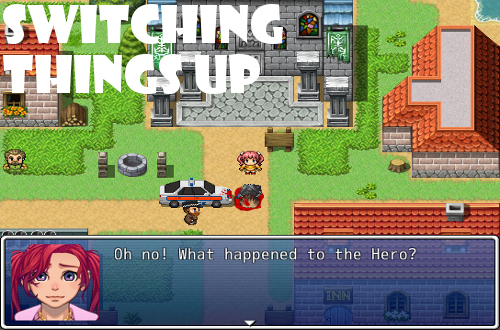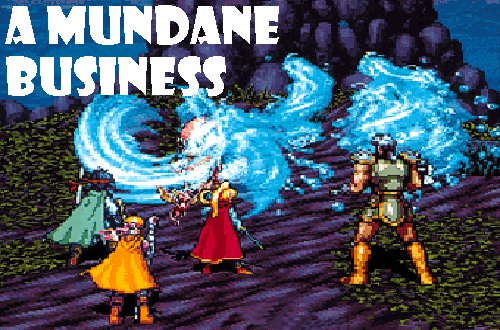
Look, I’m well aware of the numerous shortcomings when it comes to Japanese role-playing games. If for some reason you don’t know about any of them, allow me to recommend The Grand List of Console Roleplaying Game Clichés, which does not specifically target Japanese-only RPGS, but many of the elements on the list do overlap. Also, if you ever want to lose yourself in the Internet for a couple hours, check out the trope pages simply for Chrono Trigger, Breath of Fire, or Final Fantasy VII. You’re welcome, and I’m sorry.
Like Clockwork is a comedy RPG that likes to take these well-known tropes, bash them in the face repeatedly, wave them around victoriously for all to see, and then do things differently. It opens with the Sleepyhead Rule, wherein the main character is awoken by his mother to start his quest. However, he is quickly killed in a freak accident involving a police car, resulting in his female companion taking up the flag to finish the hero’s quest. Yup, instead of playing as the brooding, sulking introvert that everyone loves and champions because whatever, you instead play as a young woman who happened to be in the right place at the right time. And she wears actual battle armor, not a metal bikini. This is just the start of spinning those known tropes on their heads.
Made for Fuck this Jam 2014 by John Roberts and created in RPGMaker, which also birthed such interesting things like Starbot and The Stoneville Mystery, Like Clockwork looks exactly as you imagined it might, compiled of a number of recognizable sprites and shapes. To the point that uncommon elements, like a cop car or massively large troll, look instantly out of place. Either way, it’s a bright, colorful RPG world spread across a handful of screens, though more time was obviously spent on the opening town area than anywhere else. Similar to other games created in RPGMaker, you can access a pause menu for stats, skills, and other things that might not even matter, though it does make more sense in this type of environment.
As you go through the early motions of Like Clockwork, your cop car companion Tam McGleish, a rather angry Scottish Detective Inspector, will complain with every breath he takes about JRPG trope after trope, calling them out right on the spot. Eventually, he even breaks the fourth wall to speak directly to the developer–and, on one occasion, cause him physical harm–in order to see things change for the better. Like when the random encounters become too much. Also, in good ol’ silly fashion, the main heroine passes out when having to make a moral choice, as if the decision is too much to handle for her frail frame. There are several other fun moments to discover that I will spill now.
All that said, it’s still a JRPG, just one that points out all the annoying bits. You must go through the annoying bits, at least once, for them to get taken away and changed into something more streamlined, modern. I found Like Clockwork to be lightly amusing, though I guess I’m not used to reading the c-word so many times, as it’s been a bit since I reread my A Song of Ice and Fire books. In actuality, I would’ve liked to play more, to get into a few more battles and level up my party, but that’s not the point here–it’s not a full game, just a snapshot of the tiresome elements of the genre. A riff. It works fine enough, but now I want to load up my years-old save data for Eternal Sonata and get my true JRPG-ing on.





